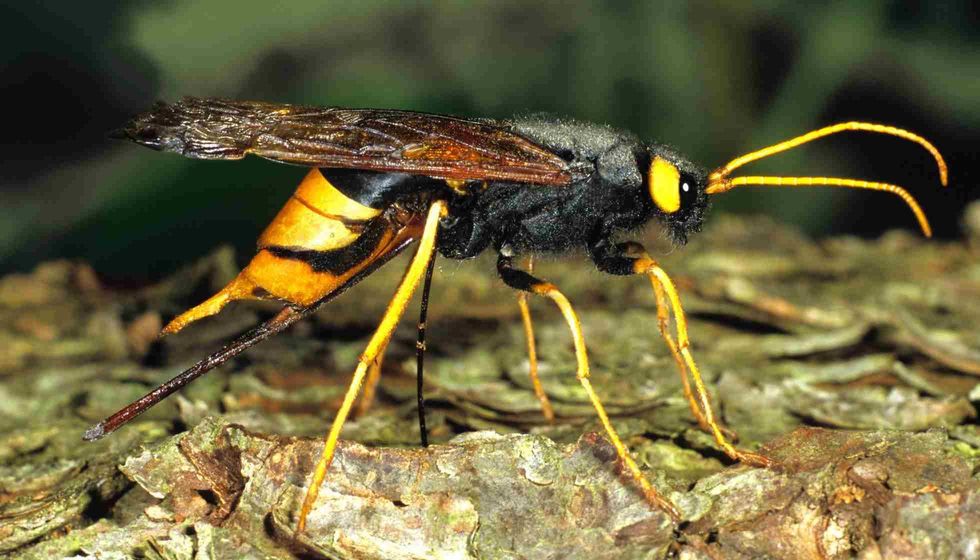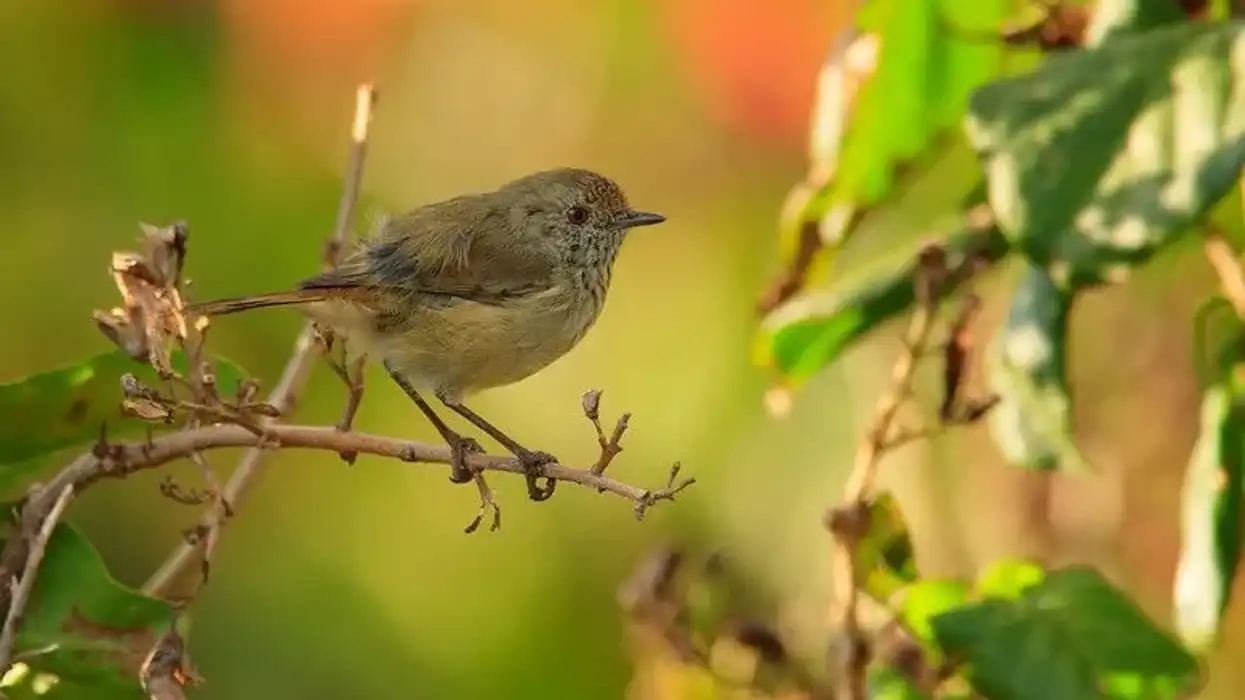There are several horntail wasps species in the world. They have a cylindrical shape and a long hornlike tail which might make them look dangerous.
These horntails belong to the category of wasps, bees, and ants. Unlike these similar deadly animals, wood wasps are not considered bad or deadly for humans. Although they are usually found bored into the wood, female horntails inject their eggs only in decayed or almost dead trees and not in fully restructured wooden furniture.
There are around 150 different types of animals belonging to the Siricidae family across the world. These wasps are found all over the United States and European countries. Out of which, four major species of wasps including the paper wasp, the brown horne, the eastern cicada killer wasps, and the yellow jacket are found in Tennessee alone.
Do read on to learn more facts about the horntail species. To read more about other wasps, do check our articles on yellow jacket wasp and cicada killer wasp.
Horntail Wasp Interesting Facts
What type of animal is a horntail wasp?
Horntails are wasps that belong to the Siricidae family of animals.
What class of animal does a horntail wasp belong to?
Horntail wasps belong to the Insecta class of animals.
How many horntail wasps are there in the world?
There are around 85 -150 different species of horntails. Although they are considered to be extremely common, their exact number is not known.
Where does a horntail wasp live?
Horntail wasps live in the United States, and a number of their species live in the wood of trees. They are found not just in open lands but in lumber wood too. They are mainly found in the regions of California, Georgia, Washington, and Oregon.
What is a horntail wasp's habitat?
These horntail wasps are also known as wood wasps because they are mainly found deposited in the softwood of trees in gardens and parks. They are also found in different kinds of wooden spaces like a trunk, lumber, bark of a tree that is decaying, or home furniture.
Who do horntail wasps live with?
Wood wasps are included in the non-social group of animals. They lead a solitary life without having much to do with their species or other insects.
How long does a horntail wasp live?
Horntail larvae develop over a period of one year to a maximum of five years inside the tree. The exact life cycle and life expectancy of them once they fly outside the nest is not clearly known.
How do they reproduce?
Although horntail wasps' mating behavior is not clear, it is known that adult female horntails lay their eggs mainly in the bark of a tree with the help of her their ovipositor.
The ovipositor is a long stinger that a female has at the end of her body. The process of laying the eggs occurs towards the end of the summer or in the early months of fall.
An adult female wood wasp, with the help of her ovipositor, drills a hole around 1-1.5 in (2.5-3.8 cm) into the wood bark and would lay lays her eggs there.
They inject an average of five to seven eggs along with fungus into the wood. The fungus deposition softens the wood around the area where the eggs are laying laid in the tree.
This helps horntail larvae to develop and feed on the softened wood. These larvae take around a year to develop inside the tree and usually travel through the inside of the wood to the outside sap, feeding on its softer parts.
They don't necessarily leave their nest even after having developed from their larvae structure.
They might instead go back to the source of the nest and emerge through the tree as an adult horntail wood wasp after a maximum span of five years. Once the adults leave their nest, they are considered to be pests by humans as their exit holes are big and visible.
What is their conservation status?
The conservation status of these insects is Not Listed under IUCN Red List. The larvae and this insect are commonly found in tree bark. It can be assumed that their population is not at stake.
Horntail Wasp Fun Facts
What does a horntail wasp look like?
Horntail wasps are insects with three parts to their body which are the head, the body, and the tail. Their cylindrical body is made up of exoskeletons and are is dark brownish-black or even blue in color.
Most wood wasps have yellow markings on their body. They have six yellowish-brown or brownish-red colored legs, and the abdomen is specifically visible in females due to their ovipositor.
Male and female insects have a hornlike tail which is usually harmless. Females are considerably larger in size than males and have two horntails, one being a stinger and the longer one being a an ovipositor which helps a female to drill through thick wood or even tree bark to lay her eggs.
How cute are they?
Although this insect is considered to be harmless, the adults have hornlike stingers, which makes make people scared of them.
How do they communicate?
Just like other wasps and bees, these horntails communicate with pheromones. These are chemicals that they spread which cannot be smelled by humans. The different pheromones help wood wasps to share a message of danger, mark their territory, as well as send a mating message during their life cycle.
How big is a horntail wasp?
These horntails are 10 times bigger than the Dicopomorpha echmepterygis species of wasps. These adult wood wasps have a size ranging between 0.7-1.6 in (1.8-4 cm).
How fast can a horntail wasp fly?
Although wood wasps are known to fly at a fast speed while making a humming sound during their flight, the exact flying speed of this insect is not known.
How much does a horntail wasp weigh?
The exact weight of horntail wasps is not known.
What are their male and female names of the species?
There are not no different names for male and female wasps. However, they can be distinguished by their size and the presence of an ovipositor in females.
What would you call a baby horntail wasp?
A baby wasp is nothing but a larva that emerges through the egg laid by a female wasp. These babies inside wood lumber are called 'larvae'.
What do they eat?
The major source of food for these pests is wood. Adults also feed on wood and drink water or nectar available in flowers.
Are they dangerous?
This pest is not at all considered to be dangerous to humans as they do not sting or bite living beings.
Would they make a good pet?
This wasp is considered as a pest rather than a pet. A female is known for laying her eggs in wood. The egg (larva) develops inside the wood and eats the wood, and only emerges after they are fully developed. They exit wood by making holes that make them look like pests to humans as they leave a mark.
Did you know You Know...
This pest goes through a complete metamorphosis throughout its life cycle. They undergo four different life stages.
They are born in the form of an egg which later turns into a larva. This larva then emerges as a pupa in the form of an immature wasp and finally turns into an 'imago' which means an 'image' in Latin. This is considered to be the final stage of this insect's development and growth process.
Do wood wasps sting humans?
Although giant wood wasps and other species of horntails have a hornlike tail, they are not considered harmful to humans as they do not release any venom. They also don't sting humans or pets.
They do use their tail to drill inside trees and if this infested wood is used by humans to build a house or furniture, they might find larvae growth leading to pest activities later.
How do you get rid of wood-boring wasps?
These horntails bore into wood when females release their eggs and place fungus inside the holes. Once the eggs hatch, the larvae try to burrow themselves into the wood and feed on the soft-infested wood too.
In cases of an infestation in your garden, the kiln drying process or the vacuum fumigation process are the only two ways to remove this pest and clear up the infested tree before another adult wasp drills any more holes into the wood.
Here at Kidadl, we have carefully created lots of interesting family-friendly animal facts for everyone to discover! Learn more about some other arthropods, including hermit crab or wolf spider.
You can even occupy yourself at home by drawing one on our Georgia insect coloring pages.










